How many tea sets does a tea lover truly need? Some might say one or two, but for many of us, the answer feels limitless. For tea enthusiasts, tea sets are cherished treasures as much as the tea itself. This is a journey into the captivating world of tea sets, tracing their roots from the rich history of ancient China to the refined elegance of Europe.
But it doesn’t stop there. Along the way, we’ll uncover the artistry behind every style and explore the essentials of tea set accessories. Finally, you’ll discover practical tips for selecting the perfect tea set—whether you’re indulging in one for yourself or searching for a thoughtful gift for a fellow tea lover. It’s not just about tea; it’s about the love of the craft, culture, and timeless beauty each tea set holds.
The Origin & Spread of Tea Sets
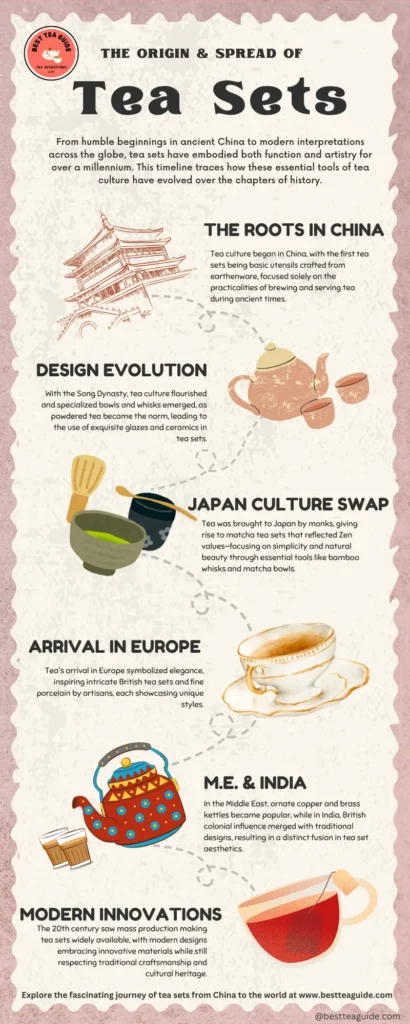
The Origins in China
- Early Beginnings (Tang Dynasty, 618-907 CE):
Tea drinking originated in China. The earliest tea sets were simple utensils made of earthenware or stoneware. - Song Dynasty (960-1279 CE):
During the Song era, Tea was whisked into a frothy brew using powdered tea, necessitating specialized bowls (chawan) and whisks. - Ming Dynasty (1368-1644 CE):
The introduction of loose-leaf tea changed tea preparation methods. The iconic Yixing clay teapot emerged during this period.
Tea Sets Spread to Japan
- During the 12th century chanoyu, or the Japanese tea ceremony, began to take shape under the influence of Zen Buddhism.
European Influence
- Arrival in Europe (16th-17th Century):
Tea reached Europe through Portuguese and Dutch traders. - British Tea Sets (18th Century):
Bone china was invented in England, combining durability with delicate designs. This became the material of choice for British tea sets.
Middle Eastern and Indian Era
- In these regions, it was common to use Copper and brass for tea kettles and serving trays.
Modern Era
Today, tea sets blend tradition with innovation. From minimalist modern designs to eco-friendly materials, contemporary tea sets cater to diverse tastes and practical needs.
The Cultural Heritage of Tea Sets
Eastern Tea Traditions
The tea traditions of East Asia have produced some of the most iconic and purpose-driven tea set designs in the world. With roots in Chinese tea culture—spanning over 5,000 years—these sets embody a harmonious blend of utility and aesthetic beauty.
Chinese Tea Sets: A Deep Dive into Gongfu Cha
Chinese tea sets are masterpieces of functionality and artistry, deeply rooted in the tradition of Gongfu Cha, or the “art of tea.” This traditional method emphasizes the meticulous preparation and appreciation of tea, celebrating the sensory experience of taste, aroma, and visual presentation. Here’s a closer look at the key elements of Chinese tea sets.
What does a Chinese tea set consist of?
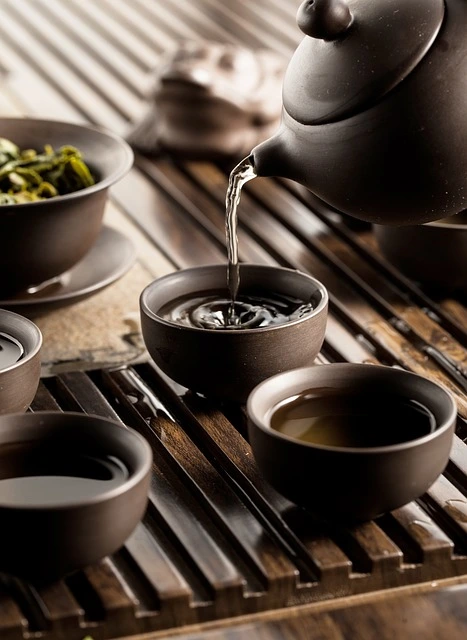
Yixing Teapots
- Material and Craftsmanship:
For the production of Yixing teapots, craftsmen use a distinctive purple clay (zisha) found in Jiangsu Province. This clay type has an identical porous nature. Over time, the clay absorbs the tea’s oils, creating a unique seasoning that enhances the flavor of subsequent brews. Skilled artisans shape these teapots by hand, often adorning them with intricate carvings or calligraphy that blend functionality with artistic expression. - Unique Qualities:
Yixing teapots have unique natural temperature regulation properties, ensuring the tea brews evenly. Tea masters often use these pots for specific types of tea, such as oolong or pu-erh, as the clay retains the essence of the tea, deepening its character over time. - Variety in Design:
These teapots come in various shapes and sizes, each crafted with a specific tea in mind. Some feature minimalist designs that highlight the clay’s natural beauty, while others boast elaborate decorations inspired by Chinese art and folklore.
Gaiwan (Lidded Bowl)
- Versatility in Brewing:
The gaiwan or a gaiwan tea set is a quintessential tool for brewing and drinking tea, consisting of three parts: a bowl, a lid, and a saucer. This elegant and practical vessel is ideal for loose-leaf teas, allowing the drinker to control the brewing process precisely. - Ease of Use:
The lid serves multiple functions: it can trap heat, control the infusion, and even act as a strainer when slightly tilted while pouring. The wide bowl provides ample space for tea leaves to expand, ensuring a rich infusion of flavors. - Cultural Aesthetics:
Gaiwans are crafted from porcelain or fine ceramics. It usually features traditional motifs such as dragons, phoenixes, landscapes, or floral patterns. They are a reflection of Chinese artistry and craftsmanship, turning every brew into a visual delight.
Tasting Cups
- Small and Purposeful:
Tasting cups, also known as pinmingbei, are small and designed to hold just a few sips of tea. Their size encourages slow, mindful drinking, allowing tea enthusiasts to fully appreciate the nuances of flavor, aroma, and color in each infusion. - Shape and Design:
These cups are often simple in shape, ensuring the focus remains on the tea itself. However, many feature delicate patterns, glazes, or hand-painted designs that add to the overall aesthetic of the tea set. - Cultural Significance:
Sharing tea in small tasting cups embodies the spirit of Gongfu Cha. Further, it fosters a communal and ceremonial atmosphere where the tea is savored as a group.
Tea Tray (Cha Pan)
- Essential for Gongfu Cha:
The tea tray is a functional and decorative element, designed to catch spills during the intricate brewing process. Made from materials like bamboo, wood, or ceramic, it provides a stable surface for the teapot, gaiwan, and cups. - Drainage System:
Many tea trays feature built-in drainage systems or removable compartments, allowing water and excess tea to flow away during preparation. This keeps the workspace clean and organized. - Aesthetic Appeal:
Tea trays often showcase elegant carvings, Chinese calligraphy, or traditional patterns, complementing the rest of the tea set while adding a touch of sophistication to the ceremony.
Tea Tools
- Precision in Preparation:
The art of Gongfu Cha involves the use of specialized tools to ensure the tea is prepared and served with care. These tools include- Tea Tongs: Used to handle hot cups and avoid burns or spills.
- Tea Strainers: Placed over cups to catch stray leaves during pouring.
- Tea Scoops: For measuring the perfect amount of tea leaves.
- Fairness Pitcher (Cha Hai): A small pitcher used to evenly distribute brewed tea among cups, ensuring consistency in flavor.
- Needles and Brushes: For cleaning and maintaining teapots and tools.
- Blending Tradition with Practicality:
Natural materials like bamboo and wood are commonly used to make these tools, aligning with nature’s harmony. These designs are not only for utility but also to enhance the visual and tactile experience of the tea ceremony.
Japanese Tea Sets
Japanese tea sets are deeply rooted in the principles of wabi-sabi. This is a philosophy that celebrates simplicity, imperfection, and the transient beauty of nature. This aesthetic is reflected in the design, materials, and usage of traditional tea sets, each piece thoughtfully crafted to harmonize with the natural world. Two primary styles of Japanese tea sets stand out: those used in chanoyu (the tea ceremony for matcha) and those used in senchadō (the art of brewing loose-leaf green tea). Each style offers a distinct glimpse into Japan’s rich tea culture.
Chanoyu (The Way of Tea) Tea Sets
The Japanese tea ceremony, known as chanoyu, roots itself in Zen Buddhism and involves highly ritualized practices. Practitioners carefully design every aspect of the ceremony, including the tea set, to evoke mindfulness, tranquility, and respect for nature.
Matcha Bowl (Chawan):
The centerpiece of a chanoyu tea set is the chawan, a hand-crafted bowl used for preparing and drinking matcha (powdered green tea). These bowls are often asymmetrical and feature natural textures, glazes, and earthy tones that reflect the imperfection celebrated in wabi-sabi. Each bowl is unique, and its form is meant to evoke the beauty of nature\u2014a rippling stream, the ruggedness of a mountain, or the warmth of earth.\n
- Bamboo Whisk (Chasen):
The chasen is an intricately crafted whisk made from a single piece of bamboo. It is used to mix matcha with water, creating a frothy, smooth tea. The craftsmanship of the chasen showcases the artisan\u2019s skill, with designs that can range from simple to highly elaborate, depending on the ceremony\u2019s formality.\n - Bamboo Scoop (Chashaku):
The chashaku is used to measure the right amount of matcha powder. Like the chasen, it is made from bamboo and embodies the natural simplicity central to the ceremony\u2019s ethos.\n - Water Ladle (Hishaku):
This element is used to transfer hot water from the kettle to the bowl. Its long, graceful handle allows for precise and elegant movement during the ceremony. - Other Elements:
Additional tools, such as the tea caddy (natsume) for storing matcha and the fukusa (silk cloth) for cleaning utensils, complete the set, reflecting the ritual\u2019s meticulous attention to detail.
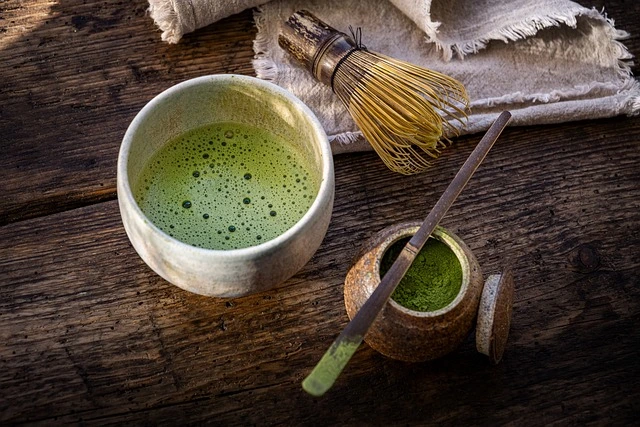
Each element of a chanoyu tea set is designed not just for functionality but to engage the senses, fostering a connection between the tea, the participant, and the environment.
Senchadō (The Way of Sencha) Tea Sets
Senchadō, the art of brewing and drinking loose-leaf green tea, is a more informal practice compared to chanoyu but still emphasizes aesthetics and mindfulness. The tea sets used in senchadō are elegant yet practical, tailored to the characteristics of Japanese green tea, such as sencha, gyokuro, or hojicha.
- Kyusu (Side-Handled Teapot):
The kyusu is the signature teapot of senchadō. Its distinctive side handle allows for precise pouring, essential for brewing delicate green teas that require controlled water temperature and steeping time. Craftsmen use clay types to make these pots, which enhances the tea’s flavor. Their designs range from minimalist to intricate, depending on the setting. - Small Tea Cups (Yunomi):
Unlike the larger bowls used in chanoyu, senchadō employs smaller tea cups, typically without handles. These cups hold just the right amount of tea for savoring its delicate flavors and aromas. The cups often feature subtle, understated designs that complement the teapot. - Cooling Bowl (Yuzamashi):
The yuzamashi is another functional yet beautiful tool. The purpose of this tool is to cool boiling water to the optimal temperature for brewing green tea. Its inclusion highlights the care and precision involved in preparing tea, ensuring that the flavors are neither bitter nor weak. - Tea Caddy (Cha-ire):
Similar to chanoyu, senchadō includes a tea caddy for storing loose-leaf tea. These containers are typically crafted from wood or ceramic and are often decorated with traditional Japanese patterns or motifs.
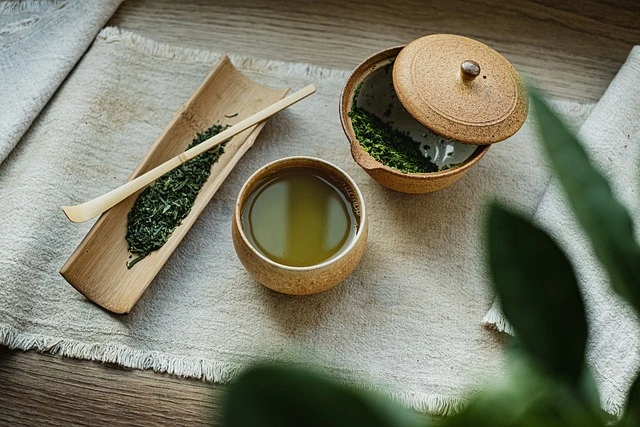
The simplicity of senchadō tea sets aligns with the wabi-sabi philosophy but also allows for more variation in design, as the practice itself is less rigid than chanoyu.
Western Tea Traditions
Western tea sets emerged during the peak of tea trade and colonial expansion, incorporating European artistic movements and functional elements suited to local tea practices.
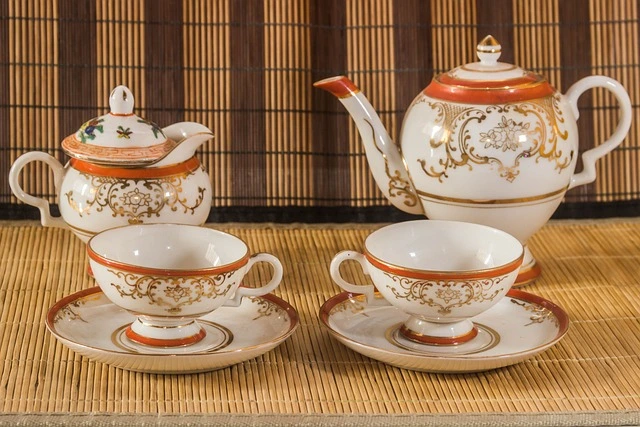
British Tea Sets
The British tradition of afternoon tea brought about the development of elaborate tea sets, often crafted from fine bone china. A typical British tea set includes:
- Large teapot (6-8 cups capacity)
- Creamer and sugar bowl
- Cups with matching saucers
- Cake plates and serving trays
- Decorative patterns, often floral or gilded
The British tradition of afternoon tea, which became a hallmark of social gatherings during the 19th century, gave rise to the development of elaborate and elegant tea sets. These sets were crafted from fine bone china, a material renowned for its durability, translucence, and delicate beauty. A typical British tea set reflects both functionality and aesthetic appeal, catering to the ceremonial and social aspects of tea drinking.
The centerpiece of the set is a large teapot, designed to hold enough tea to serve 6-8 cups, making it ideal for sharing during social occasions. Accompanying the teapot are a creamer for milk and a sugar bowl, essential for customizing each guest’s cup to their taste.
Cups with matching saucers are an integral part of the arrangement, providing an elegant way to serve and enjoy tea. Alongside these, cake plates and serving trays will be ideal to present accompanying treats such as scones, pastries, or finger sandwiches, which are staples of traditional afternoon tea.
British tea sets come with decorative patterns, showcasing floral motifs, gilded accents, or other intricate designs. These patterns reflect the artistic sensibilities of the time, adding an element of sophistication and charm to the tea-drinking experience. Together, the components of a British tea set create a cohesive and refined ensemble, embodying the timeless elegance of this cherished tradition.
Continental European Sets
European tea sets reflect regional artistic influences, including:
- Art Nouveau: Flowing, organic forms
- Art Deco: Geometric and modernist patterns
- Classical Revival: Inspired by Greco-Roman motifs
- Often produced by renowned porcelain manufacturers such as Meissen and Limoges
Materials and Craftsmanship of Tea Sets
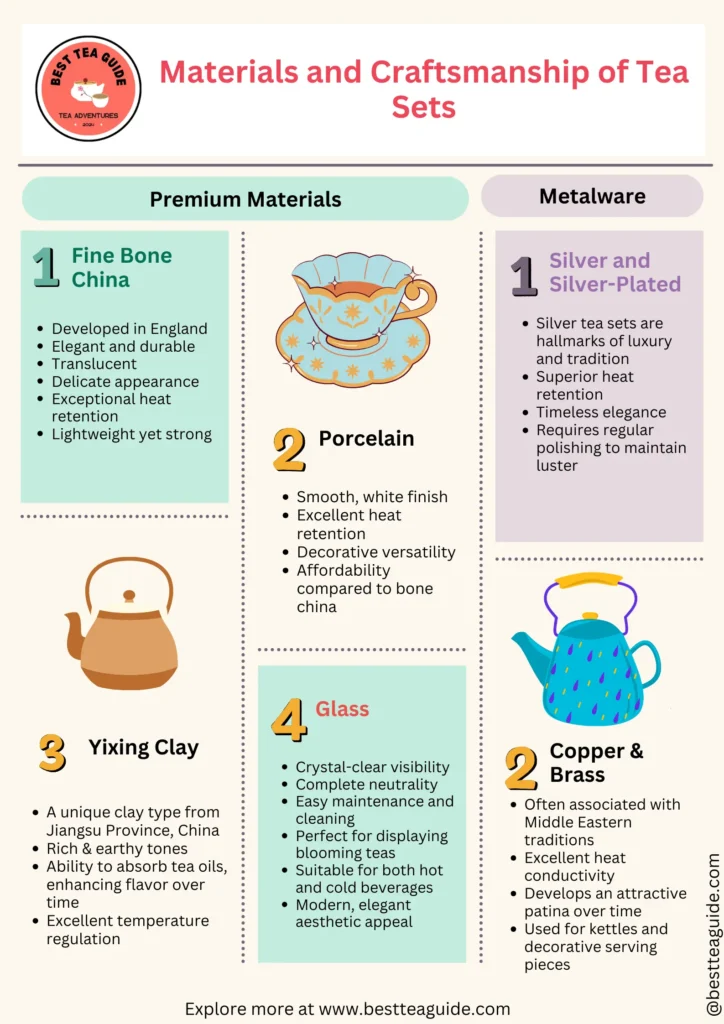
Choosing the Right Tea Set
Key Considerations
- Intended Use:
- Formal occasions
- Daily personal enjoyment
- Ceremonial purposes
- Decorative display
- Tea Type:
- Black tea (larger pots, durable materials)
- Green tea (smaller pots, temperature-sensitive)
- Oolong tea (porcelain or clay)
- Herbal teas (versatile materials)
- Maintenance Requirements:
- Dishwasher-safe vs. hand-washing
- Polishing needs (for metal sets)
- Durability concerns
- Space and Storage:
- Available display space
- Storage constraints
- Portability requirements
Material Comparisons
- Porcelain/Bone China: (porcelain tea set)
- Pros: Elegant, durable
- Cons: Fragile, often expensive
- Glass:
- Pros: Showcases tea color
- Cons: Poor heat retention, fragile
- Metal:
- Pros: Durable, excellent heat retention
- Cons: Can alter tea flavor, requires polishing
Final Thoughts
Tea sets are more than practical tools—they are vessels of cultural heritage and artistic expression. Whether you seek a functional daily set, a ceremonial masterpiece, or a collector’s item, understanding the rich history and craftsmanship behind tea sets will enhance your appreciation and guide your selection. As tea culture evolves, tea sets continue to bridge the past and present, offering timeless beauty and functionality to tea enthusiasts around the world.



